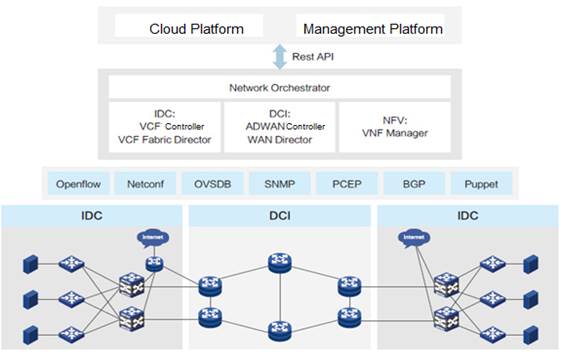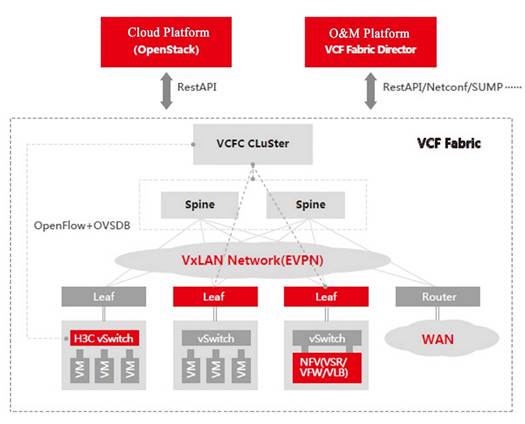H3C's SDN Solution for the Internet Industry
27-08-2018The network infrastructure of the Internet industry can be divided into data center networks (DCN) and data center interconnections (DCI). Rapid business innovation and growing user bases impose ever-increasing demands upon networks, and pose great challenges to the underlying infrastructure. One of these challenges is network operation under heavy loads. Network operations can be divided into two levels. One level is network operation and maintenance (O&M). Both DCNs and DCIs face pressures related to rapid delivery, rapid change, rapid fault diagnosis, and elastic expansion. By contrast, the complexity of DCNs depends on the number of fabric switches, and can be addressed using certain automatic O&M methods. DCIs, however, are cross-WAN networks, involving not only network devices, but also optical transmission, with more complex topology and traffic. Thus the complexity of DCIs in terms of O&M is significantly higher than that of DCNs. The other level is network management, which covers issues such as maximizing usage of expensive DCI network line resources, maximizing usage of outbound Internet bandwidth resources, and finding an appropriate role for DCI networks in the development of hybrid cloud services (like traditional carriers, the Internet industry has now begun to consider how to construct "smart pipelines").
Cloudification presents another great challenge, which manifest firsts in the DCN layer. First of all, DCNs must meet basic requirements – including those of virtualization, dockerization, virtual machine migration, and network automation deployment – after cloudification. After that, they must meet requirements related to business innovation, eg support of virtual private cloud (VPCs), bare machine rental, hybrid clouds, and value-added services. For a DCI network, the main requirement imposed by business cloudification are support of innovation in service modes, such as remote disaster recovery, dual activation, and hybrid cloud access.
Faced with these challenges, attempts have been made to solve networking problems from the perspective of computers. The SDN concept relies on the fact that the underlying forwarding plane supports streamlined generic forwarding behavior. Standardized upstream-facing interface (Socket) of the network operating system interact with network applications in the layer above through exchange of streamlined instructions with the upper network operating system (Controller). SDN's layered decoupled forwarding, control and implementation architecture provides great flexibility in network design, planning and management, facilitating not only network developers' innovation, but also flexible network user control, and DEVOPS-based automatic O&M based on simple programming. Since 2009, H3C has been monitoring the development of SDN technology, and engaging in research and development of related products, and can thus now provide comprehensive SDN solutions to many of the difficulties encountered by the Internet industry. Their overall architecture is as follows:

H3C provides a Network Orchestrator – a kind of networking choreographer – to achieve coordination with the upper application system. Depending on the application scenario, H3C can provide different types of controller platforms. For data center scenarios, H3C offers VCF Controller and Director platforms. For WAN scenarios, H3C offers ADWAN controllers, and NFV Managers to implement lifecycle management of NFV devices. These SDN controllers uses Openflow, Netconf, BGP and other standard downstream interface protocols to achieve coordination with the infrastructure layer, which includes data center switches and routers or switches in DCI networks.
In the data center use case, the overall architecture of H3C's SDN solution is as shown below:

VCF Fabric uses RestAPI, Netconf, SNMP and other interface protocols to connect with H3C VCF Fabric Director enabling automatic O&M of the entire DCN. Compared with traditional O&M platforms from the perspectives of design, implementation, monitoring, and optimization, H3C VCF Fabric Director has the following advantages: visualization of the entire data center (DC) planning process; inheritabilty, traceability, and deployability of DC planning and scheduling, allowing decoupling of IT capability from personnel capacity; automated deployment or one-click DC construction; decoupling of configuration and device, reducing the number of configuration files, and enabling automatic, unified deployment of computing, storage and network resources; total visualization of resources and business monitoring, mapping relations and topologies between physical and virtual resources and services, and clarifying the service system's usage of physical resources; fault detection and end-to-end diagnosis and debugging, based on multidimensional DC data; and application-driven automation optimization and adjustment, providing application-oriented closed-loop O&M capabilities.
At present, H3C's DC SDN solution has been applied at Tencent, Alibaba, JD, Qihoo, YY and other Internet companies.
The H3C's application-driven SDN WAN solution uses intelligent tuning, and permits risk monitoring, fault identification, trend prediction, etc. The solution as a whole consists of three layers:
Management layer: a Director or third-party management platform, for overall business management and orchestration, policy definition, monitoring and visualisation.
Controller layer: based on the OpenDaylight open source platform, this supports integration of all kinds of applications. The upstream interface provides the API for these, while the downstream interface achieves internetworking with devices via standard protocols.
Network device layer: managed by the Controller, this supports protocols such as SNMP, NETCONF, PCEP, BGP-LS, BGP Flowspec, and Openflow, along with Segment Routing, VxLAN, MPLS TE, and Openflow hardware forwarding.
The Controller collects information on topology, traffic, equipment and connections across the entire network via the downstream interface, using BGP-LS, SNMP and other protocols. All this information is stored in the Ccontroller's database. Through the resource orchestration layer, customers hand off user-defined apps policies to apps for storage. For traffic whose network status is compliant with such polices, these apps calculate user-policy-consistent traffic paths, generate forwarding entries, and label device stacks or flow entries, passing these on to devices to guide network forwarding. Through this solution, WAN resources are tightly integrated, changes in resource are monitored in real time, and the network can be visualized in its entirety. Centralized control and global scheduling are carried out to deliver application-driven WAN services consistent with user applications and network conditions.
To date, H3C's SDN WAN solution has been deployed commercially for uses including Internet traffic scheduling, Internet outbound traffic scheduling, DDoS prevention, MAN, and industry-specific traffic scheduling.
You can find excellent H3C partners, or you can become one of them to build a
partnership with H3C and share success together.
